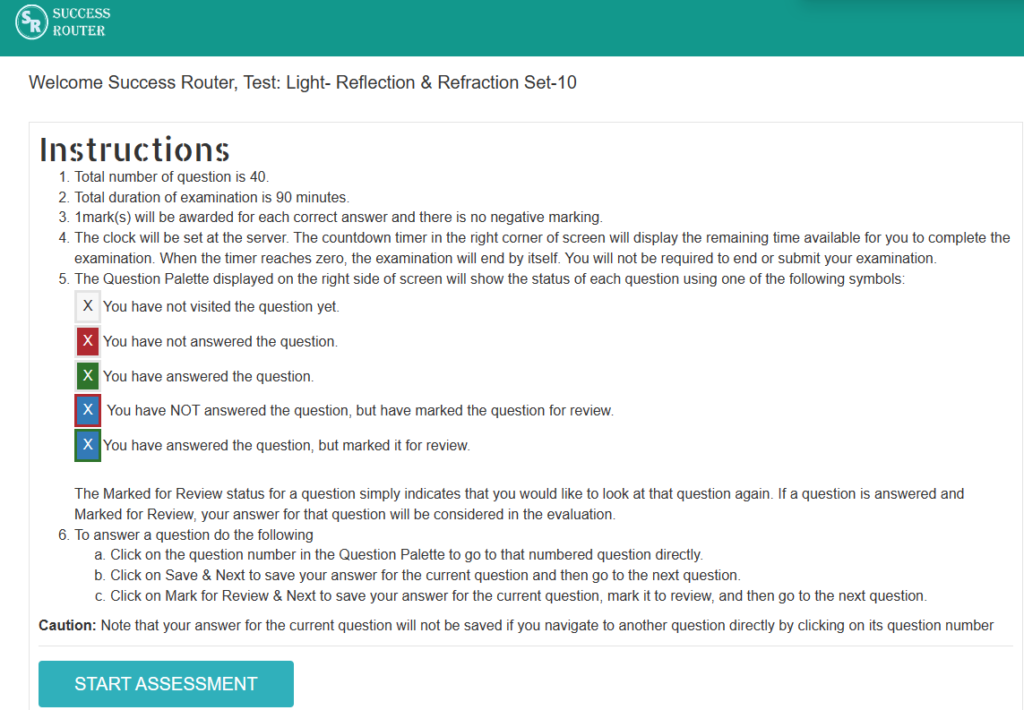Last Updated on August 26, 2024 by XAM CONTENT
Hello students, we are providing assertion and reason questions for class 10 science. Assertion reason questions are the new question format that is introduced in CBSE board. The resources for assertion reason questions are very less. So, to help students we have created chapterwise assertion reason questions for class 10 science. In this article, you will find assertion reason questions for CBSE Class 10 Science Chapter 6 Life Processes.
| Chapter | Life Processes |
| Type of Questions | Assertion Reason Questions |
| Nature of Questions | Competency Based Questions |
| Board | CBSE |
| Class | 10 |
| Subject | Science |
| Useful for | Class 10 Studying Students |
| Answers provided | Yes |
| Difficulty level | Mentioned |
| Important Link | Class 10 Science Chapterwise Assertion Reason |
Assertion Reason Questions on Life Processes
Directions:
(a) Both A and R are true and R is correct explanation of the assertion.
(b) Both A and R are true but R is not the correct explanation of the assertion.
(c) A is true but R is false.
(d) A is false but R is true.
Q. 1. Assertion: Photosynthesis takes place in green parts of the plants.
Reason: Photosynthesis always takes place in leaves.
Difficulty Level: Medium
Ans. (c)
Explanation: Photosynthesis takes place in green parts of the plant like leaves. In a few cases the stem is green and also takes part in photosynthesis. The green part of the leaves and stem contains cells which contain the green pigment called chlorophyll. Chlorophyll traps solar energy and converts it into chemical energy during photosynthesis.
Q. 2. Assertion: Capillaries are the thinnest blood vessels.
Reason: Capillaries connect the branches of arteries and veins.
Difficulty Level: Medium
Ans. (b)
Explanation: Capillaries are the thinnest blood vessels and connect the branches of arteries and veins. Capillaries allow the exchange of materials like nutrients, respiratory gases, hormones, etc. between the blood and body cells through tissue fluid.
Q. 3. Assertion: The plants store some of the waste products in their body parts.
Reason: Raphides are the solid waste products of plants.
Difficulty Level: Medium
Ans. (b)
Explanation: The plants store some of the waste products in their body parts. For example some of the waste products are collected in the leaves, bark and fruits of the plants. The plants get rid of these wastes by shedding of leaves, peeling of bark and fruits. Some of the plant wastes get stored in the fruits of the plant in the form of solid bodies called raphides. These are removed when the fruits, get detached from the plant. For example, the ‘Yam’ fruit has needle shaped raphides on its surface.
Q. 4. Assertion: The movement of water and dissolved salts in xylem is always upwards.
Reason: The upward movement of water is due to low pressure created by transpiration.
Difficulty Level: Medium
Ans. (a)
Explanation: The plants take in water (containing dissolved minerals) from the soil through their roots. This water, called xylem sap is carried by the xylem vessels to all the parts of the plant. The xylem vessels of the root of the plant are connected to the xylem vessels of its stem. So, the water (containing dissolved minerals) enters from the root xylem vessels into stem xylem vessels. The xylem vessels of the stem branch into the leaves of plants. So, the water and minerals carried by the xylem vessels in the stem reach the leaves through branched xylem vessels. Since the cells of the leaf are losing water by transpiration, so water from the xylem vessels in the leaf will travel to the cells by osmosis to make up this loss of water. Thus, water is constantly being taken away from the top of the xylem vessels in the leaves thus reduces the effective pressure at the top of the xylem vessels. The pressure at the top of the xylem vessels (in the leaves) is lowered whereas the pressure at bottom of the xylem vessels remains high. Due to this water flows up the xylem vessels.
Q. 5. Assertion: Blood takes up oxygen from the alveolar air and release CO2 during exchange.
Reason: The concentration of O2 is more in alveolar air.
Difficulty Level: Easy
Ans. (b)
Also check
- Chemical Reactions and Equations Class 10 Assertion Reason Questions Science Chapter 1
- Human Eye and Colourful World Class 10 Assertion Reason Questions Science Chapter 10
- Life Processes Class 10 Assertion Reason Questions Science Chapter 6
- Light – Reflection and Refraction Class 10 Assertion Reason Questions Science Chapter 10
You may also like
Download eBooks for CBSE Class 10 Science Life Processes
Helpful Links for CBSE Class 10 Science Preparation
- Download 125 Important Case Study Questions for CBSE Class 10 Science
- Download 220 Important Assertion Reason Questions for CBSE Class 10 Science
- Download 225 Practical Based Questions for CBSE Class 10 Science
- Download 65 Important Numerical Problems for CBSE Class 10 Physics
- Download 60 Important Diagram Based Questions for CBSE Class 10 Physics
- Download 150 Most Repeated Questions for CBSE Class 10 Science
- Download Chapter Test for CBSE Class 10 Science
Topics from which assertion reason questions may be asked
- Understand the characteristics of living organisms.
- Identify and differentiate between autotrophic and heterotrophic nutrition.
- Explain the process of photosynthesis and cellular respiration.
- Describe the structure and function of the human respiratory system.
- Explore the components and functions of the human circulatory system.
- Understand the process of excretion and the role of the excretory system.
You are going to study the above topics in class 10 life processes chapter. So, assertion reason questions based on above topics may be asked.
We hope the given Assertion and Reason Questions for Life Processes Class 10 Science helps you in your learning.
Quiz
| Topic | Life Processes |
| Useful for | CBSE Class 10 Students |
| Type of Questions | MCQs |
| No. of Questions | 20 |
| Solutions | Instant Solutions after Completion of Quiz |
| Quiz Link | Click here to Take Test |
| Price | Free |
How to take quiz or test using the given link
It’s quite simple!
Step 1: Click on the given link. You will see the below screen.

Step 2: Fill in the necessary details. There is no need to register. Just fill your email and name and click on the button “Take Assessment”. The below screen will appear.

Step 3: Click on start assessment. Now you are ready to take test.

Frequently Asked Questions (FAQs) on Life Processes Assertion Reason Questions
Q1: Define life processes.
A1: The maintenance processes that sustain the orderly structure of living beings are called life processes.
Q2: Why do living beings need energy to maintain their orderly structure?
A2: Environment factors tend to breakdown the ordered nature of living organism, so they need energy to maintain their
orderly structure.
Q3: Name the uniform source of energy used by all living organisms.
A3: ATP
Q4: What are heterotrophs?
A4: Heterotrophs are organisms which cannot synthesise their own food and depend directly or indirectly on plants for nutrition.
Q5: What is peristalsis?
A5: It refers to rhythmic contraction and relaxation of muscles of alimentary canal which push the food forwards.
Q6: What are the functions of HCl in stomach?
A6: Functions of HCl in stomach are:
(a) HCl provides acidic conditions to activate gastric enzymes.
(b) It kills bacteria and other germs.
Q7: What are the two ways of oxidation of glucose to provide energy?
A7: Anaerobic and aerobic respiration
Q8: Why is anaerobic respiration considered less efficient?
A8: It is the process of incomplete oxidation of glucose and it releases less energy than aerobic respiration.
Q9: Why is it not advisable to sleep under trees at night?
A9: The air around the trees lacks oxygen and contains more carbon dioxide at night as photosynthesis stops at night but respiration continues. Consequently, plants also consume oxygen and evolve carbon dioxide. During daytime rate of photosynthesis is faster than rate of respiration therefore plants consume carbon dioxide and evolve oxygen.
Q10: What are the components of the transport system in highly organised plant?
A10: Higher plants have vascular system consisting of xylem and phloem. Xylem contains tracheids and vessels. Phloem contains sieve tubes and companion cells.
Q11: Name the passage in sequence through which urine passes from kidneys to outside in humans
A11: Kidneys → ureters → urinary bladder → urethra → outside the body
Q12: What is osmoregulation?
A12: Osmoregulation is the life process by which an organism controls the amount of water, solutes and ions in the body.
Q13: Are there any online resources or tools available for practicing life processes assertion reason questions?
A13: We provide assertion reason questions for CBSE Class 10 Science on our website. Students can visit the website and practice sufficient assertion reason questions and prepare for their exams. If you need more assertion reason questions, then you can visit Physics Gurukul website. they are having a large collection of assertion reason questions for all classes.


